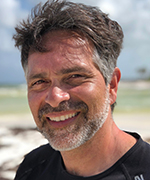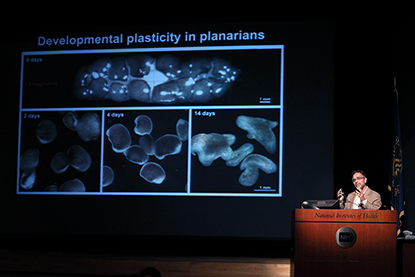Finding the Elixir of Life
Alejandro Sánchez Alvarado Studies How Flatworms Regenerate
Alejandro Sánchez Alvarado may have found the elixir of life in a simple organism that scientists have mostly ignored: the tiny flatworm planarian Schmidtea mediterranea. The worm has an amazing ability to regenerate itself from the smallest bits of its tissue.

CREDIT: TATJANA PIOTROWSKI, STOWERS INSTITUTE FOR MEDICAL RESEARCH
Alejandro Sánchez Alvarado
“Alejandro has studied and pioneered work in planarians,” said National Institute of General Medical Sciences Director John Lorsch, who introduced him at the DeWitt Stetten Lecture on October 10, 2018. “He sequenced the worm’s genome and developed a wide variety of approaches to search for the specific cells that allow regeneration to occur from even very small pieces of the animal.”
Sánchez Alvarado—a Howard Hughes Medical Institute investigator at the Stowers Institute for Medical Research (Kansas City, Missouri) and recipient of many prestigious awards including being elected to the National Academy of Sciences in 2018—is fascinated by the origins of life.
The Earth is 4.5 billion years old, and the fossil record suggests that multicellular life may have originated 650–700 million years ago. But only those organisms possessing an exoskeleton endured the process of fossilization, he explained; there is no verifiable and uncontroversial fossil record for soft-bodied organisms. He pointed out that microfossils (tiny remains of bacteria, protists, fungi, animals, and plants) recently characterized in western Australia, “one of the oldest land masses on the planet,” may indicate that life was trying to establish itself 3.5–4 billion years ago. The findings, while controversial, “suggest that maybe life has been trying to establish itself on this planet from day one,” said Sánchez Alvarado. “Maybe what we’ve seen in the record [are] multiple attempts for complex life to emerge.”
Sánchez Alvarado figured that one way to explore the origins of complex life was to focus on planarian flatworms, simple organisms that are famous for their regenerative ability. (Geneticist Thomas Hunt Morgan became fascinated with this discovery more than 100 years ago.) The most remarkable feature of the asexual form of this planarian is that you can “slice and dice them…in a number of ways and every one of those fragments will go on to generate a complete animal” within two weeks, said Sánchez Alvarado. “That’s the equivalent of cutting [off] my little finger and watching [it] regenerate me.”

CREDIT: CHIA-CHI CHARLIE CHANG
Alejandro Sánchez Alvarado, who spoke at a recent WALS lecture, explores the origins of life by focusing on planarian flatworms, simple organisms that are famous for their regenerative ability.
In an attempt to find the source of the regenerative potential of these animals, Sánchez Alvarado’s lab combined single-cell RNA sequencing, flow cytometry, genomics, and high-resolution imaging techniques. His lab identified and isolated a subtype of a proliferating cell called a neoblast that is capable of regenerating the whole animal (Cell 173:1593–1608.e20, 2018; DOI:10.1016/j.cell.2018.05.006). These cells express a cell-surface protein-coding gene, TSPAN1; single-cell transplantation of a TSPAN1-positive cell can completely rescue a lethally irradiated host that no longer has any stem cells. Sánchez Alvarado concluded his talk with a movie that showed for the first time ever a neoblast cell dividing in a Petri dish. He hopes that because it is now possible to culture these cells in vitro, a whole new era for the regeneration field will open up.
Sánchez Alvarado believes we all have a bit of “planaria” hidden in our genomes, according to his website. “You and I are turning over a number of cells equivalent to our body weight every year.”
“In addition to his many research accomplishments, Sánchez Alvarado [is] also committed to inspiring the next generation of scientists,” said Lorsch. He brings the magic of science to middle-school and high-school students with hands-on classroom activities to study regeneration and stem-cell biology.
The annual DeWitt Stetten lecture, part of the Wednesday Afternoon Lecture Series (WALS), was established by the National Institute of General Medical Sciences (NIGMS) in 1982 in honor of Stetten, who was the third director of NIGMS. To watch the videocast of Sánchez Alvarado’s October 10, 2018, WALS Stetten lecture, “Understanding the Source of Regenerative Ability in Animals,” go to https://videocast.nih.gov/launch.asp?26100.
This page was last updated on Tuesday, April 5, 2022
